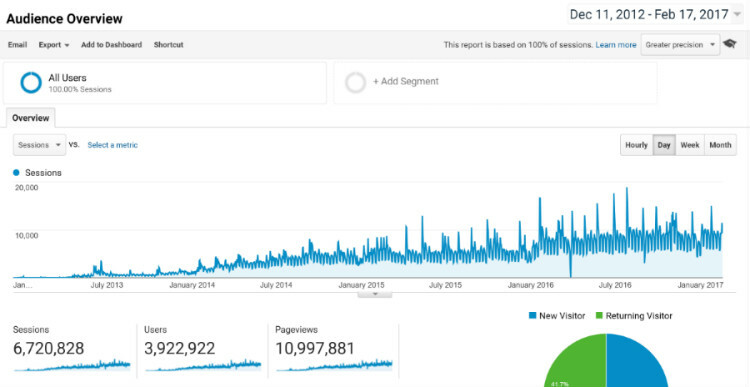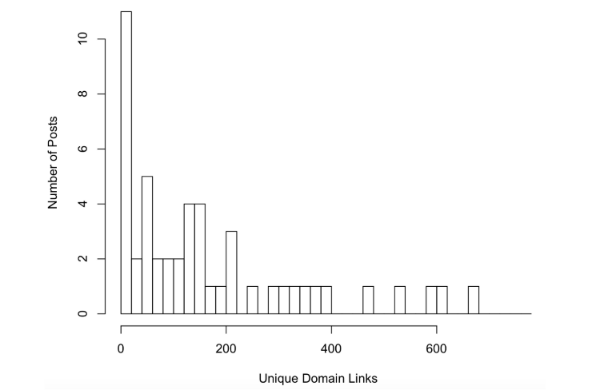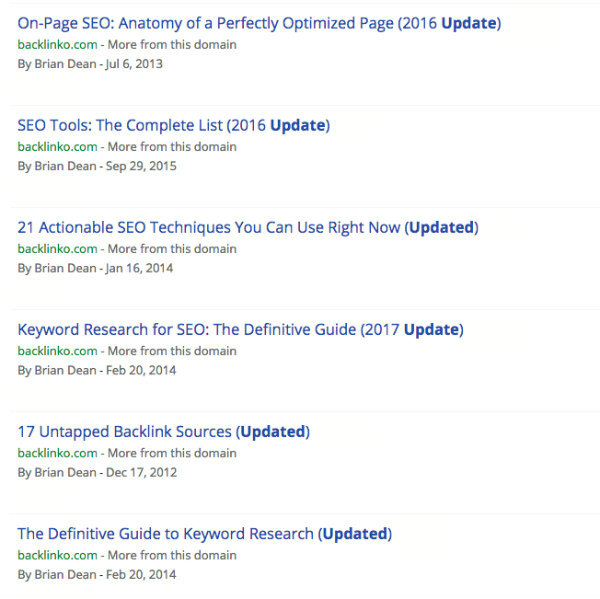What is the ideal frequency for publishing content? In my view is there is no ideal frequency as it depends upon your site, audience and objectives. However, you can adopt different content strategies from high frequency publishing through to Jay Baer‘s advice that you should only publish when you have something worthwhile to say. In this post I want to focus on the “less is more” content strategy.
You can drive higher shares, gain more links and attract significantly more traffic using a ‘less is more’ approach. Yes, you really can drive more traffic by publishing less content. It is not magic as I will prove below.
Brian Dean of Backlinko has executed this content strategy to great effect. Brian has published just 53 posts over the last five years, less than one a month. These posts have driven nearly 4m visitors to his site. The average shares and links per post are what most of us can only dream of: an average of 2,490 shares, and 275 links from unique domains, for each post.
What is the ‘Less is More’ content strategy?
A successful ‘less is more’ strategy involves producing original, in-depth and referenceable content. This enables you to build an audience through demonstrating your authority and expertise; and by developing your reputation.
The strategy involves:
- Original content from research to case studies
- Referenceable content
- Comprehensive content including curationLong form content
- Doubling down on successful strategies with by refreshing and re-promoting your content
- A strong focus on amplification and promotion
‘Less is more’ refers to the number of articles published not the amount of effort involved. Researching and creating high quality content once a month can take a lot more time than writing say three short blog posts a week.
The ‘less is more’ approach is not suitable for everyone and before I outline the ‘less is more’ content strategy I wanted to say a few words about equally valid approaches which involve higher frequency publishing. If you want to skip this, you can jump straight to the ‘less is more’ strategy.
The future is more content
I personally believe Mark Schaefer got it right when he talked of ‘content shock’. The amount of content published every day is huge and it is only going to increase. The number of people with internet access is still growing and publishing tools are easier to use, particularly video. Getting attention in a world of content shock is difficult. A core task for all content marketers is to reach, build and retain an audience.
To compete in a world of content shock many publishers have adopted a high frequency publishing strategy, often over 1,000 articles a day. Many blogs have also had success by increasing their content production. This has been particularly marked where blogs have increased their output from say one post every week or two, and increased it to say three posts a week. This may be due to the regularity of content helping to build an audience and a brand.
Research from Hubspot to Neil Patel has also found that increasing content can increase both traffic and leads. Back in 2012 Hubspot kicked off the debate with data showing that as the number of monthly blog posts increased so did traffic and inbound leads. Neil Patel also found that increasing Kissmetrics blog posts from 5 to 6 a week increased monthly traffic by 18%.
However, there are logically limits to the efficacy of increasing content production which I suspect is related to your audience, type of site and your ability to continuously create quality content. The Content Marketing Institute experimented with publishing content twice a day but hit a point of diminishing returns. They now publish once a day which currently appears optimal. I think it was Robert Rose who wisely said “More content is better, until it isn’t”.
For many sites increasing content production is a valid strategy, though you need need to monitor the return on investment and assess when you are reaching the effectiveness threshold. However, there is an alternative approach …
Why the ‘Less is More’ content strategy works
At its core the ‘less is more’ strategy is based on building an audience through producing original, in-depth, researched and referenceable content which enhances your authority and reputation.
The best ‘less is more’ example I have come across is Brian Dean at Backlinko. Brian produces high quality, well researched and referenceable content every 4 weeks or so. Despite this infrequent publishing, Brian has driven 4 million visitors to his site with just 53 posts.
Let’s have a detailed look at Brian’s content and how well it performs.
Case study: Backlinko content and performance
I reviewed 53 posts published by Brian on Backlinko over the last 4 years. I didn’t include short posts to promote webinars but I did include video posts and book chapters, which are published as separate posts. I have listed all of the posts at the bottom of this article for transparency.
The average and median shares for these 53 posts are both incredibly high. The average number of shares is 2,490 and the median is 1,280. To put this into context, when we reviewed 127,000 articles published by Hubspot B2B customers we found median shares of just 22 and when we reviewed the top 95 B2B blogs including sites such as Hubspot, we found median shares of 106. To have median shares of over 1,000 is very high.
What is even more staggering is the number of unique linking domains. The average per post is 275 and the median is 137. When we looked at a million posts at random we found over 50% did not receive a single link.
Brian has kindly shared his analytics data below so we can see how his traffic has grown consistently over time. His 53 posts have attracted almost 4m visitors and 11m page views.
So how does Brian achieve such success? I think it is fundamentally down to a ‘less is more’ strategy.
1. Posting frequency
The number of posts published each year by Brian is relatively low as we can see below.
| Year | Number of Posts | Average Shares | Average Links | Total Shares | Total Links |
| 2012 | 4 | 95 | 300 | 3,720 | 1,201 |
| 2013 | 14 | 3,203 | 508 | 44,839 | 7,106 |
| 2014 | 16 | 2,578 | 208 | 41,242 | 3,320 |
| 2015 | 14 | 1,763 | 89 | 24,685 | 1,239 |
| 2016 | 4 | 3,918 | 4,221 | 5,670 | 1,688 |
We can see that older content in 2013 and 2014 has gained many more links. I think in part this is because Brian regularly updates his content, so whilst there may be fewer new posts, there is a constant updating of older content.
Whilst the frequency of posting is low the number of shares is high and the number of links is very high. For example, in 2013 just 14 posts drove 44,839 shares. For sites with a median of 106 shares that would take over 400 posts! Even for sites with a median of over 500 shares, which is rare, it would take over 80 posts to generate the same number of shares.
Low frequency posting allows you to spend more time on content amplification including distribution and promotion. If you are publishing a post every day it is simply harder to spend the time amplifying each piece of content. However, I think the primary reason for Brian’s success is the content itself.
2. Original, reference content
We can see from the histogram below how many of Brian’s posts consistently attract over 100 unique domain links. The top performing post received over 2,000 links from unique domains. I think the high number of links is due to producing original, researched and referenceable content.
Core characteristics of ‘Less is More’ content
The core characteristics of a successful ‘less is more’ strategy include:
- Content knowledge and expertise
- Referenceable content
- Long form content
- Comprehensive content including curation
- Original content from research to case studies
- Doubling down on successful content with updating and repromotion
- Amplification and promotion
This content approach is fundamentally about building your authority and reputation, which in turn will help you to build an audience.
The ‘less is more’ approach is not for everyone. However, there are some principles that will work across the board such as doubling down on your best content.
Here are my reflections on creating a successful ‘less is more’ content strategy.
Be an expert: research, discuss and reflect
If you are going to create valuable content for your audience you need to have something unique to contribute. Typically this means being an expert or at least reading widely and curating relevant material. Ideally you will be an expert on your topic through research, reading and reflection. You will share this expertise by investing considerable time in crafting long form, original content. It is this combination of expertise and investment that makes your content valuable.
Referenceable content
One of the key features of Brian’s content is the production of comprehensive, reference content. Let’s take the 7 posts below as examples. Each of these is almost an essential reference work for people that work in SEO.
- Article Total Shares Linking Domains Google’s 200 Ranking Factors: The Complete List 17,400 2,461 On-Page SEO:
- Anatomy of a Perfectly Optimized Page (2016 Update) 11,800 1,165
- SEO Tools: The Complete List (2016 Update) 8,900 393
- Conversion Rate Optimization Techniques (100+ Techniques and Free PDF) 7,500 145 21
- Actionable SEO Techniques You Can Use Right Now (Updated) 7,300 525
- We Analyzed 1 Million Google Search Results. Here’s What We Learned About SEO 7,300 1,379
- Keyword Research for SEO: The Definitive Guide (2017 Update) 4,000 614
Brian also frequently updates these reference posts to keep them current, as we will see below.
Long form content
The average number of words per Backlinko post is 2,335. Thus Brian is consistently producing in-depth and detailed posts. Brian’s most shared post on Google ranking factors is over 5,000 words.
Comprehensive content and curation
The other striking feature of Brian’s content is its comprehensive nature. I mentioned above the average length of his posts. Brian signposts this comprehensiveness in the post title for example: ‘complete list’ and ‘definitive guide’.
Brian also uses numbers to demonstrate comprehensiveness, for example:
- 201 Powerful SEO Tips (That Actually Work)
- Conversion Rate Optimization Techniques (100+ Techniques and Free PDF)
Content curation is also a key feature of Brian’s content pulling together for example, 201 SEO tips or 100 optimization techniques.
Original research and case studies
One of the things I love about Brian’s content is that it is based on original research. It is not content or insights that I can read about somewhere else. I particularly like his use of case studies, as by their nature they tend to be unique. As a general observation I feel case studies are not used enough by content marketers.
Here are some examples of Brian’s research and case studies:
- We Analyzed 1 Million Google Search Results. Here’s What We Learned About SEO
- Viral Marketing Case Study: How a Brand New Blog Generated 17,584 Visitors In One Day
- White Hat SEO Case Study: How To Get a #1 Ranking
- Content Strategy Case Study: 36,282 Readers + 1,000 Email Subscribers
- Awesome! This SEO Campaign = 15% More Organic Traffic
Doubling down on content that works: Updating and repromoting
Let’s take another look at some of Brian’s top content. In the six examples below Brian is updating and repromoting his successful content. For example, the top post is a 2017 update of his 2014 SEO Keyword Research Guide.
Commenting on updating Brian says:
“I usually update a post if it needs an update in some way and/or it’s not ranking as well as I’d like. For example, let’s say I’m looking at publishing a post in May. If all of my content is up-to-date and ranking where I think it should be, I’ll write something new.If not, I’ll update and relaunch an old post.”
I think this is a great approach, it is not all about creating new content.
Amplification
There is no point as Jay Baer says in investing in promoting content that has failed organically. You will get much greater returns if you focus on your best content. Using the ‘less is more’ approach you will have greater time and resources to promote and amplify each piece of content Clearly if you publish just once a month rather than three times a week you can give each piece of content more attention.
Summary
The ‘less is more’ strategy is primarily about building an audience through building your authority and reputation. This requires content that is:
- Original, such as research and case studies
- Long form and detailed
- Comprehensive including curated content
- Referenceable such as guides, statistics and reports
The strategy has a strong focus on amplification and promotion. This means doubling down on successful content with updating and repromotion. As Brian says before you write a new article check that your current content is all updated and ranking where you think it should be. Often you can get greater success updating and repromoting an older post than by writing a new post.
By using this ‘less is more’ content strategy you really can drive higher shares, gain more links and attract significantly more traffic by publishing less content.
I hope this is helpful and would love to hear from people that have adopted a ‘less is more’ content strategy.
Annex – List of Brian’s posts
- Google’s 200 Ranking Factors: The Complete List
- On-Page SEO: Anatomy of a Perfectly Optimized Page (2016 Update)
- SEO Tools: The Complete List (2016 Update)
- Conversion Rate Optimization Techniques (100+ Techniques and Free PDF)
- We Analyzed 1 Million Google Search Results. Here's What We Learned About SEO
- Actionable SEO Techniques You Can Use Right Now (Updated)
- Viral Marketing Case Study: How a Brand New Blog Generated 17,584 Visitors In One Day
- Awesome! 16 Powerful SEO Copywriting Secrets (That Work Fast)
- E-commerce SEO (Advanced Guide + Step-By-Step Case Study)
- 17 Insanely Actionable List Building Strategies (That Work Fast)
- Keyword Research for SEO: The Definitive Guide (2017 Update)
- White Hat SEO Case Study: How To Get a #1 Ranking
- This SEO Checklist = 48.7% More Organic Traffic [Case Study]
- Viral Content: 21 Data-Driven Techniques That Work Fast
- SEO Strategy Case Study (#1 Ranking & 963% More Traffic)
- 201 Powerful SEO Tips (That Actually Work)
- How to Get 260.7% More Organic Traffic In 14 Days (New Strategy + Case Study)
- Link Building Case Study: How I Increased My Search Traffic by 110% in 14 Days
- 17 Untapped Backlink Sources (Updated)
- Link Building for SEO [The Definitive Guide]
- Video SEO: The Definitive Guide
- Want to Increase Website Traffic? Follow These 4 Steps…
- How to Create a Squeeze Page That Converts at 21.7% (Case Study)
- Content Strategy Case Study: 36,282 Readers + 1,000 Email Subscribers
- Awesome! This SEO Campaign = 15% More Organic Traffic
- YouTube SEO: The Ultimate Guide
- How To Boost Conversions by 785% in One Day (The Content Upgrade)
- The Definitive Guide to Keyword Research (Updated)
- How to Get High Quality Backlinks (Without Guest Posting)
- How To Boost Conversions by 529% in 45-Minutes (Two Step-By-Step Case Studies)
- Why Google Hates Your Site (Hint: It Has Something to Do With Trust Rank)
- How to Rank For Any Keyword (This is The Exact 1-2 Punch I Used to Rank #4 for Backlinks)
- Google Keyword Planner – No-Nonsense Guide to Finding Awesome Keywords
- How to Get Backlinks With Guestographics
- How to Find Long Tail Keywords – Keyword Research: The Definitive Guide
- CPA Marketing: The Ultimate Guide
- How I Generated 166,000 Visits and 5000 Email Subscribers From One Post…And Rank #5 for The Keyword Link Building (New Case Study)
- You + These 2 Steps = More Traffic
- [New Video] How to Get Higher Rankings and More Traffic in 2015 (Plus: The 4 Deadly “Content Promotion Killers”)
- The Definitive Guide to Guest Blogging
- New Step-By-Step Case Study: How I Generated 16,696 Visitors In One Week With The Content Roadshow
- Here’s Where You Can Download Your Ebook, “7 Deadly SEO Mistakes” (No Charge)
- How to Get More Traffic (The Smart Way). The Secret? Share Triggers.
- Step-By-Step Case Study: How I Created a Post That's Generated 113,817 Visitors and 2,000 New Email Subscribers
- SEO Content — Keyword Research: The Definitive Guide
- How 3 Normal People Defied The Odds, Beat Up On Their Big Brand Competitors (and Got a Ton of Organic Traffic In The Process)
- Keyword Competition – Keyword Research: The Definitive Guide
- The Definitive Guide to Link Building
- Keyword Research Tools – Keyword Research: The Definitive Guide
- Keyword Commercial Intent – Keyword Research: The Definitive Guide
- How to Zoom to the First Page With The Upside Down Guest Post
Categories
Content MarketingCategories
Content MarketingThe Monthly Buzz⚡
Subscribe to BuzzSumo's monthly newsletter to:
Stay up-to-date with the best of the best in content marketing 📝
Get data-informed content, tips and tidbits insights first 👩🏻💻
Read top shared content by top marketing geeks 🤓
Try
Enter any topic, term or url to search to see BuzzSumo in action. It’s free!
100% free. No credit card required.


